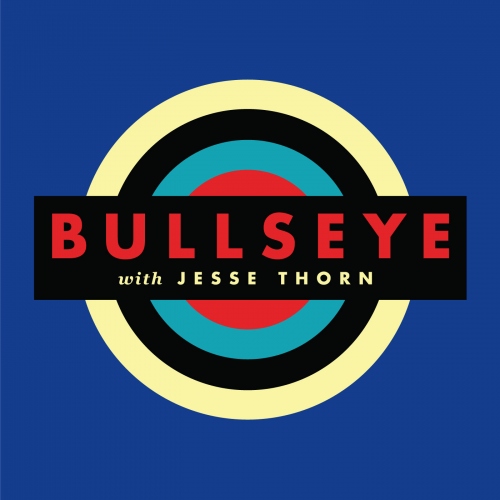I enjoyed this description of a creative brainstorming technique that involves connecting previously unconnected dots.
creativity

Welcome to a very special edition of Podcast Saturday. In the focuslight today is Jesse Thorn's flagship pop culture podcast on his Maximum Fun network. Yesterday Jesse traveled from his southern California home to the wilds of Portland, Oregon to entertain us with a live recording of Bullseye. I've been a fan since Jesse's show was The Sound of Young America and it was a treat to see his rapport with guests in person. Jesse has a great way of teasing the humor and emotional highlights out of someone's story during his interviews. Much like my desert island favorite Judge John Hodgman, the podcast isn't just about the surface content. The content here is meeting artists and hearing about their creative process. Its hidden message is about being a decent, curious, earnest person which makes it a subversive podcast indeed.
I also really like this video series (?) Jesse is working on called I Work Here that features artists giving tours of their workspaces. Last night he showed: I Work Here: Inside the Work Space of 'Wondermark' Creator David Malki!
Update: Forgot to link to this great interview in Willamette Week: Bullseye’s Jesse Thorn on the Early Days of Podcasting...
I also really like this video series (?) Jesse is working on called I Work Here that features artists giving tours of their workspaces. Last night he showed: I Work Here: Inside the Work Space of 'Wondermark' Creator David Malki!
Update: Forgot to link to this great interview in Willamette Week: Bullseye’s Jesse Thorn on the Early Days of Podcasting...
Josh made a beautiful thing and shared the process. This is inspiring to read, and if you haven't seen Josh's geometric paintings you should take a look. Also fun seeing discussion of this pop up on Hacker News and MetaFilter (of course).

Listen up you stinklinguists! This formula for creating new, creative swear words is the crapgrenade you've been waiting for. (NSFW, obviously.) What I find even more hilarious are phrases that are not remotely related to swear words but sound like they are. Prime example: this cracks me up every time I think about it.

This is a fun article aimed at aspiring visual artists but I think there's good advice here for anyone who makes things. I especially appreciated Embed thought in material and Learn the Difference Between Subject Matter and Content.
This post resonated on many levels, especially: "Today you have to choke your way through the money-making miasma to find the joy." I agree that a separate search engine would be nice but automatically differentiating indie content from sponsored content seems like an impossible task. Maybe more human curation of the web is the answer. (Said by a human who likes to curate the web.)
In focus on this Newsletter Wednesday is Austin Kleon's newsletter. You may remember Austin from his books about creative work like Steal Like an Artist or his latest Keep Going. Each week he shares 'ten things worth sharing' and I always find interesting fuel for thought. I'm also inspired by the personal tone of his writing and it's something I'd like this blog to get closer to as it grows up.
-
A nice jQuery image cropping library.
-
How-To: Art.
-
nice instructions for calculating proximity with SQL Server.
-
Ze Frank on creativity, etc. [via MeFi]
How I Write a Hack
I was chatting with Brian Sawyer (Hacks Series editor) earlier today about writing Hacks and the process I use, and he encouraged me to share the way I work. I think it's a bit like making sausage, you don't necessarily want to know what an author uses to put something together. But hopefully sharing my process will help other tech writers, or may encourage others to share the way they work. So here's a quick look at how I write a Hack.
Everyone has their own methods and process for writing, and here are the methods I used for Yahoo! Hacks. I printed out and taped the following numbered lists to my monitor, and reading over them helped me come up with supporting material for each Hack.
That's it! Of course much of this process is tied to the conventions established in the excellent Hacks series, and I hope sharing this will encourage others to take a stab at writing for the series. You'll have to see if you can spot these methods in action when Yahoo! Hacks is out in a month or so.
Everyone has their own methods and process for writing, and here are the methods I used for Yahoo! Hacks. I printed out and taped the following numbered lists to my monitor, and reading over them helped me come up with supporting material for each Hack.
Hack Template
I view a Hack as a project the reader can accomplish. The reader also needs to know why they might want to accomplish the project and have an idea of what the project should look like when they're finished. Here's my template:
- Why this hack is needed (story, build desire)
- Describe the relevant features
- Hack prerequisites
- Hack code/procedure
- Example of the Hack in action
- Brief summary (why the reader rocks!)
- If possible, Hack alternatives
Hack Process
If the Hack is going to be centered on a piece of code, I like to write that first and get it working smoothly. Once the code is ready to go, parts 3, 4, and 5 are fairly easy to put together. If the Hack is more basic/explanatory, I'll often start at part 1.
Hack Motivations
Part 1 is always the hardest for me, so my other lists revolve around how to frame a Hack for a reader. I've found that William Zinsser's On Writing Well has been a big help to me, and some of these ideas are straight from the book.
Central Transaction
Zinsser talks about a central transaction for any piece of writing, and the one I came up with for Hacks is: Hacker's love affair with technology. I felt like I wanted to convey excitement about technology throughout the book, and I always kept this phrase in mind.
Telling a Story
I only wrote in first person using I once or twice in Yahoo! Hacks. I was more comfortable writing in third person. I still tried to keep the idea of telling a story in mind, and I found this list helpful:
- How was I drawn into the Hack?
- What emotional baggage did I bring?
- How has the Hack changed my life?
- Tell with humanity and warmth.
Building Desire
I've found that it's not always easy to explain why someone should be interested in a particular Hack, but I think it's crucial. Here's the list of potential motivations that I tack up:
- aesthetic (appreciation of beauty or good taste)
- competitive (giving an advantage or keeping up)
- gregarious (enjoying the company of others)
- snobbish (regarding social inferiority)
- exhibitionist (attract attention, show-off)
- maternal (protect, warm and nurturing)
Hack Subjects
Part 2 of the template is important because it's a chance to describe the service in detail. I always assume that the reader only has a passing knowledge of whatever I'm writing about, so I like to describe the details of basic features of a service in part 2. For example, if I have a Hack that shows how to scrape a site for movie times and create a custom email with listings in their area, I first want to show someone how to get movie times the standard way through the website, along with any tips and tricks for using the site. Then I'll go into taking those features a step further with the Hack. I feel that without understanding a feature as it was intended to be used first, the Hack won't make as much sense.
Hack Summary
I'm not very good at this, but I try to add a sentence or two at the end of the Hack that taps into the motivation from the beginning of the Hack. I think it gives the Hack a sense of completeness.
That's it! Of course much of this process is tied to the conventions established in the excellent Hacks series, and I hope sharing this will encourage others to take a stab at writing for the series. You'll have to see if you can spot these methods in action when Yahoo! Hacks is out in a month or so.